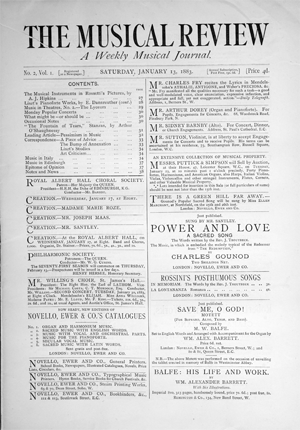The Musical Review
Prepared by Benjamin Knysak
Online only (2023)

Published Novello, Ewer and Co., only 26 issues of The Musical Review [RIPM code LMR] appeared from 6 January to 30 June 1883. Each issue contained sixteen or twenty pages in two column format. Advertisements— largely of new musical works, compilations and pedagogical texts issued by the publisher—appeared at the beginning and end of each issue with additional notices found before the editorial, generally five to six pages in total. Although the journal was short-lived, the high quality of criticism and the editor’s musical-critical aims represent an important voice in this period of British musical history.
The Musical Review was initiated by the editor, Francis Hueffer (1845-1889), a learned and progressive critic. Born in Germany, educated in Berlin and Leipzig, he received a doctorate from the University of Göttingen with a critical edition of the works of the Catalan troubadour Guillem de Cabestany. After moving to London in 1869, Hueffer began a journalistic career, writing for The Fortnightly Review, Macmillan’s Magazine, The New Quarterly Review and became musical critic for The Times.
Hueffer was a musical progressive who sought to promote the works and performances of major continental composers – e.g., Richard Wagner, Franz Liszt, Johannes Brahms, Hector Berlioz – and to support British composers he saw as extensions of this line. In the first issue, after a declaration of editorial independence, Hueffer professes the previous year, 1882, to have been “one of the most important in the history of English art” owing to performances of new works of Hubert Parry, Charles Villiers Stanford, and Alexander Mackenzie, in addition to performance of Wagner’s operas from Rienzi to Götterdämmerung and the premiere of Charles Gounod’s oratorio La Rédemption.1 Hueffer saw this as a growing internationalization of English musical taste and the development of a new English school of composition.
In The Musical Review, Hueffer reports extensively on the events surrounding Wagner’s death in February 1883, including Wagner’s funeral, memorial concerts, and reactions from throughout Europe. The British premiere of Berlioz’s Requiem (Grande messe des morts) receives great attention, as do Hans Richter’s symphonic concerts which often featured works of Liszt, Brahms, and Antonin Dvořák. Gounod’s oratorio La Rédemption is given outsized attention, perhaps due to the journal’s publisher, Novello, Ewer and Co., holding publication rights to Gounod’s works in England. Alexander Mackenzie’s opera Colomba, with a libretto by Hueffer, is regularly cited.
Serialized articles of note include Edward Dannreuther’s survey of Liszt’s piano works, the composer Frederick Corder’s composition treatise, A. J. Hipkins’s survey of musical instruments in Dante Gabriel Rossetti’s paintings, Friedrich Niecks’s attempt to understand Chopin’s personality, W. Barclay Squire on biographical discoveries concerning William Byrd, J. A. Fuller-Maitland’s history of the “Dies Irae” hymn, and Albert Visetti’s vocal treatise. Much published correspondence concerns the Handel Festival and early attempts at historically-informed performance practice, especially issues of temperament and tuning. International coverage is provided by a group of correspondents, including Louis Sigismond in Paris, Filippo Filippi in Milan, H. Sutherland Edwards in Brussels, and Martin Roeder in Berlin. Perhaps owing to Hueffer’s ties to the English artistic and literary avant-garde—Hueffer married a daughter of the painter Ford Madox Brown—The Musical Review published poems from major figures including Dante Gabriel Rossetti, Arthur O’Shaugnessy, Christina Rossetti, A. C. Swinburne (his “Death of Richard Wagner”), and Mathilde Blind.
The journal ended abruptly with the twenty-sixth issue which contains a bitter note that commercial success could not yet be obtained for a musical journal of stature, “unless, indeed, the tone of its articles were lowered to meet a broader popular taste.”2 Hueffer would continue writing musical journalism, and in a few years, he became editor of The Musical World where from 1885 to 1888 he would reinvigorate the then-nearly fifty-year old British musical standard.
This RIPM Index was produced from a copy held in the Special Collections of the Irving S. Gilmore Music Library at Yale University. This copy lacks the final two pages of advertising; these pages were provided by the Royal Academy of Music.
1 The Musical Review 1, no. 1 (6 January 1883): 13-14.
2 The Musical Review 1, no. 26 (30 June 1883): 416.
